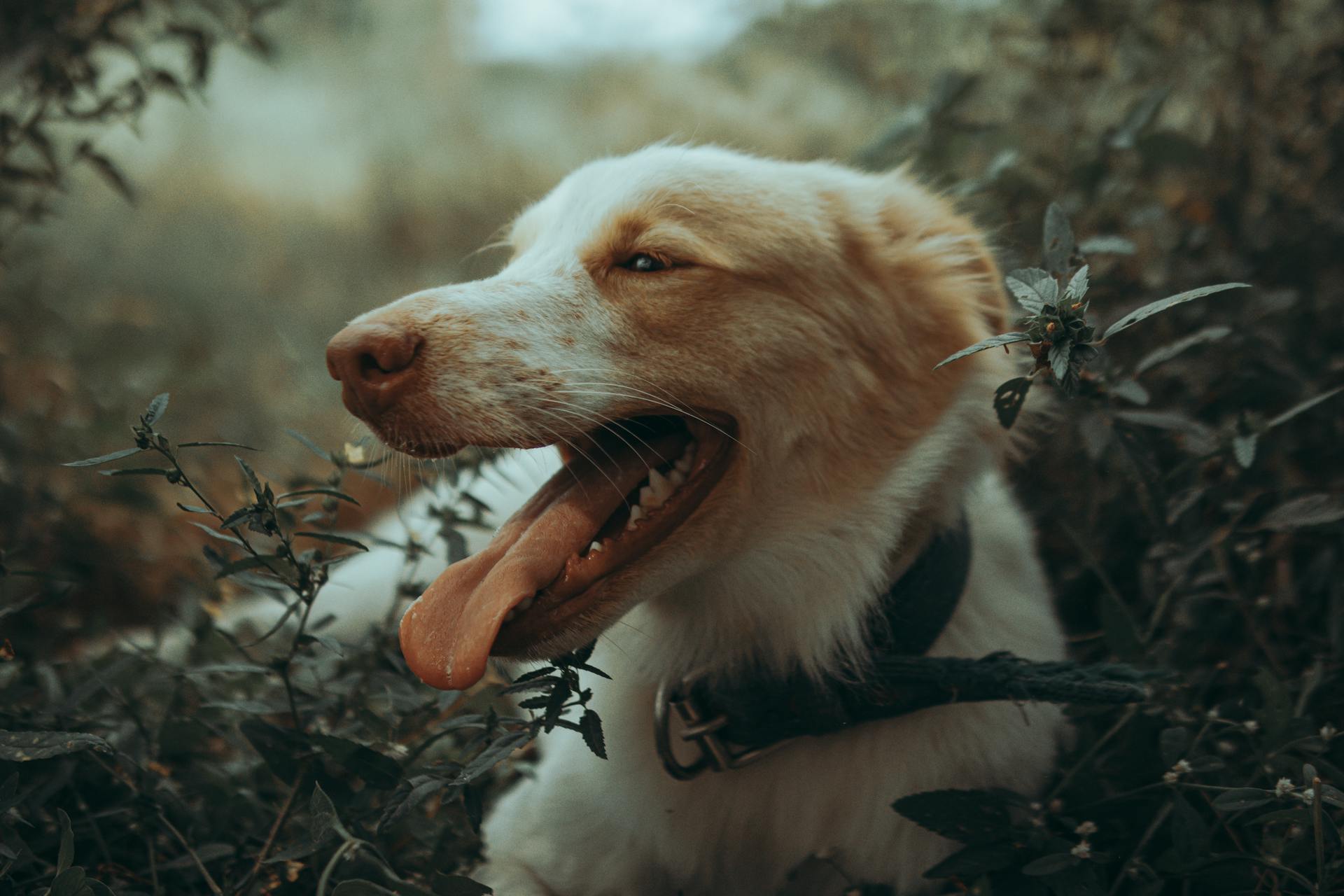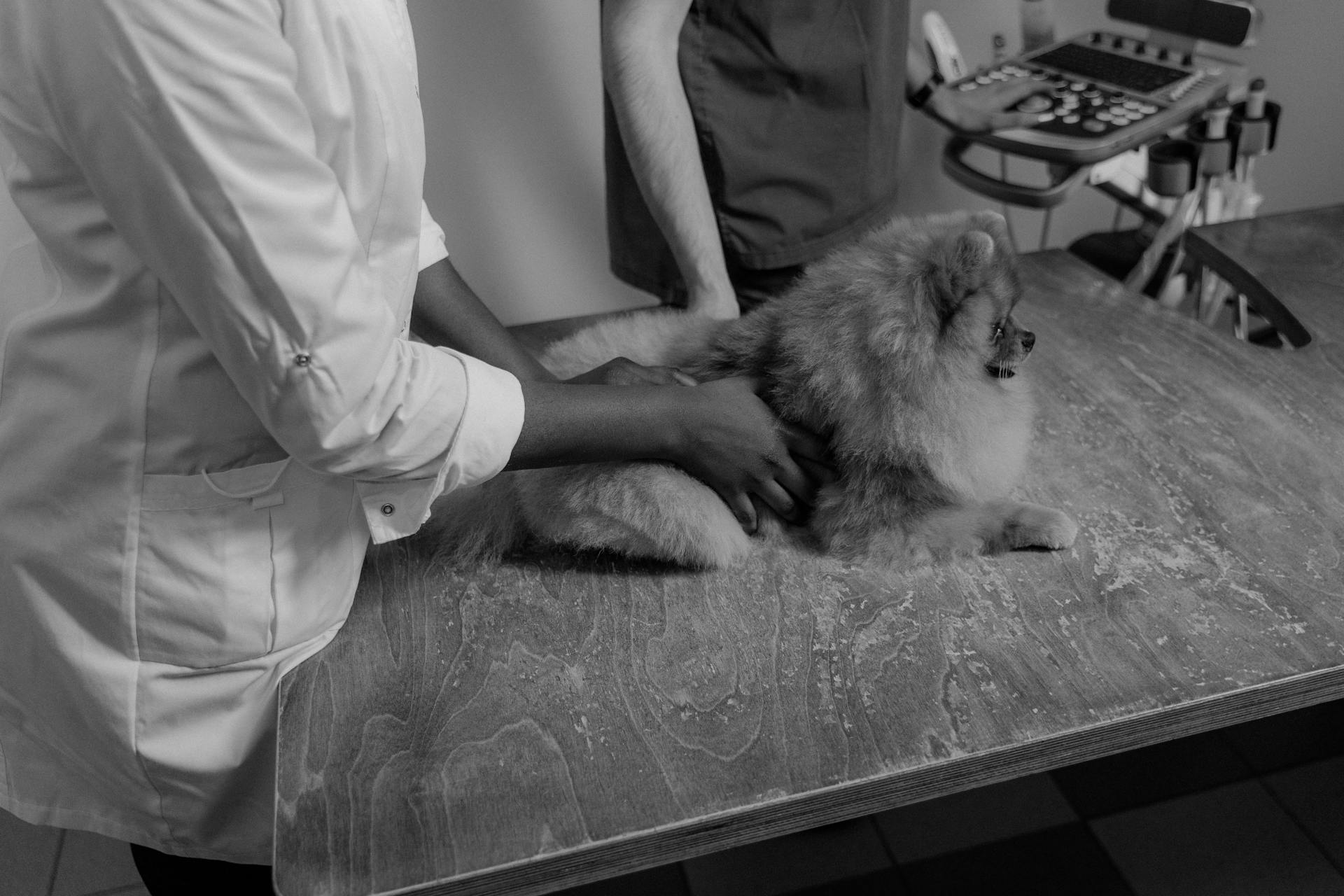
Dogs can be prone to gum problems, just like humans. According to the American Veterinary Dental Society, periodontal disease is the most common health problem affecting dogs.
Bad breath, or halitosis, is a common sign of gum disease in dogs. This is often caused by the buildup of plaque and tartar on the teeth.
Regular dental care can help prevent gum problems in dogs. Brushing your dog's teeth daily with a dog-specific toothbrush and toothpaste can help remove plaque and tartar.
Many dog owners don't realize the importance of regular dental care for their pets.
For more insights, see: Free Dog Health Care
Understanding Canine Health
Gum health is an integral part of a dog's overall wellness and should be taken seriously by every pet owner.
Regular examination can be lifesaving, as identifying potential problems early on can help prevent serious health complications.
Oral hygiene isn't just about keeping your dog's breath fresh; it can also prevent systemic problems affecting organs beyond the dog's mouth.
Integrating gum care into your daily routine can preserve your dog's smile and contribute to their overall health.
A proactive approach to oral hygiene can mean the difference between a healthy dog and one beset with preventable health issues.
Consider reading: Veterinary Oral Health Council Dog
Recognizing Gum Problems
Your dog's gum health is crucial for their overall well-being, and catching gum disorders early can make a big difference.
Regular check-ups with your vet can help identify issues before they progress. Be vigilant about your dog's gum health by regularly checking their gums for signs of disease.
Discolored teeth, bad breath, and inflamed or bleeding gums are all symptoms of canine periodontitis.
Here are some common signs of periodontal disease in dogs:
- Bleeding or inflamed gums
- Discolored teeth (brown or yellow)
- Loose or missing teeth
- Bad breath (halitosis)
- Irritability
- Weight loss
- Bloody or “ropey” saliva
- Drop in appetite
- Favoring one side of the mouth when chewing
- Excessive drooling
- Blood in water bowl or on chew toys
If left untreated, periodontal disease can cause significant chronic pain in your dog, leading them to self-isolate to avoid showing weakness to predators.
Causes and Prevention
Gum overgrowth in dogs can be caused by certain medications, systemic diseases, or be idiopathic, so it's essential to seek veterinary advice if you notice an increase in your dog's gum size.
Preventive care is a sure way to avoid serious dental problems for your dog, and regular dental cleanings with your vet can prevent gum diseases that could lead to more severe health concerns if left untreated.
Bacteria builds up in a dog's mouth and can eventually develop into plaque, which hardens within two to three days, making it difficult to scrape away from teeth.
Poor nutrition and diet can play a role in the development of plaque and bacteria that cause periodontal disease, and poor grooming habits, such as frequent licking, can also contribute to the problem.
Regular dental appointments with your vet, at least every six months, can help identify any trouble spots and prevent issues from developing into unmanageable situations.
Tacky Dehydration
If your dog's gums feel sticky or dry instead of their usual moist texture, this is a clear sign that your pet may be dehydrated. Ensure they have constant access to fresh water.
Dehydration can sneak up on your dog quickly, especially in hot weather or during intense exercise. Monitor your dog for any other symptoms requiring a vet's attention.
A dry or tacky mouth can be a warning sign that your dog is not drinking enough water. Make sure your dog's water bowl is always full and easily accessible.
Related reading: Do Water Additives for Dogs Teeth Work
Skin Growths

Skin Growths can be alarming to notice on your dog. Observing unusual growths, bumps, or warts on your dog's gums can be alarming.
Growths on the gums may range from benign overgrowths to more severe conditions. A vet should evaluate new or changing growths on your dog's gums.
Some skin growths can be a sign of a more serious underlying issue, such as a skin infection or allergies. If you notice any changes in your dog's skin, it's always best to consult with a vet.
Warts on the gums are a common issue that can be caused by a virus.
Consider reading: Dogs Gums Bleeding When Chewing Toy
What Causes?
Bacteria in your dog's mouth can accumulate and eventually develop into plaque, which meets other minerals and hardens within two to three days.
This buildup of bacteria causes the immune system to fight back, leading to inflamed gums and more obvious signs of gum disease.
Poor nutrition and diet can play a role in the development of the plaque and bacteria that eventually cause periodontal disease.

Dogs that lick themselves frequently can also contribute to poor oral hygiene and increase the risk of gum disease.
The alignment of teeth can also make a difference, as dogs with crowded teeth are more susceptible to gum disease.
Dirty toys and unclean environments can also contribute to the accumulation of bacteria in your dog's mouth.
A balanced diet and specific supplements can help strengthen your dog's gums and teeth, reducing the risk of gum disease.
If this caught your attention, see: Homemade Food for Dogs with No Teeth
How to Prevent Hair Loss
Preventing hair loss is easier than you think. Regular veterinary check-ups can help identify underlying health issues that may be contributing to hair loss.
Just like your dog's oral health, your pup's overall health is connected to their coat. If you catch any problems early, you can prevent hair loss and other issues.
Daily grooming is a must for preventing hair loss. Brushing your dog's coat daily can help prevent matting and tangling, which can lead to hair loss.
Dental health is also connected to hair loss. If your dog has periodontal disease, it can lead to a weakened immune system, which can cause hair loss.
Regular veterinary check-ups can help identify any underlying health issues that may be contributing to hair loss.
A different take: What Food Is Good for Dogs Skin and Coat
How to Prevent Infection

Preventing infection in your dog's mouth is crucial to maintaining their oral health. Regular dental cleanings with your vet can remove plaque and tartar that can lead to gum diseases.
Daily brushing of your dog's teeth is essential to prevent bacteria and plaque from forming. Choose a toothpaste made specifically for dogs to ensure their safety.
Dental chews, dog food, and chew toys designed to address dental disease can help reduce tartar development, but they should not replace daily brushing. Think of them as an add-on to regular oral care.
A balanced diet and specific supplements can strengthen your dog's gums and teeth, making them more resistant to infection. Chew toys and treats designed for dental health can also help reduce plaque.
Your dog's oral health should be evaluated at least once every six months to catch any potential issues early on. Keep an eye out for signs of infection, such as inflamed or swollen gums, missing teeth, or changes in appetite. If you notice any of these symptoms, schedule an appointment with your vet right away.
Preventive Dental Care
Preventive dental care is essential for maintaining your dog's overall health. Regular dental cleanings with your vet can prevent gum diseases that could lead to more severe health concerns if left untreated.
Schedule professional dental cleanings with your vet at least once every six months to remove plaque and tartar. Daily tooth brushing with canine-specific toothpaste can also prevent gum disease and the buildup of harmful bacteria.
Preventing periodontal disease is possible with regular dental appointments and at-home care. You can prevent the disease by being proactive with your dog's oral health, just like you would with your own.
Daily brushing with a toothpaste made specifically for dogs can prevent plaque and bacteria from forming. Dental chews, dog food, and chew toys can also help address dental disease and reduce tartar development, but don't replace brushing with them.
Bad breath can be a sign of underlying dental issues, such as kidney disease or poor oral hygiene. Excessive bad breath can indicate a need for better oral care practices.
Choosing the right dental products for your dog is crucial. Opt for toothbrushes with soft bristles and toothpaste formulated for canine use, and avoid human toothpaste, which can harm your pet.
Recommended read: Canine Mouth Cancer Life Expectancy
Frequently Asked Questions
What color are a dog's gums when dehydrated?
A dehydrated dog's gums are typically pale.
Sources
- https://thewagette.com/healthy-dog-gums-vs-unhealthy/
- https://www.vets-now.com/pet-care-advice/pale-gums-in-dogs/
- https://www.lakecross.com/site/blog-huntersville-vet/2020/07/22/periodontal-disease-dogs-symptoms-treatment
- https://www.thefarmersdog.com/digest/what-color-should-my-dogs-gums-be/
- https://www.guilfordjamestownvet.com/site/blog-greensboro-vet/2020/08/13/periodontal-disease-dogs-symptoms-causes-treatment
Featured Images: pexels.com


